Improving Optical and Electrical Characteristics of GaN Films via 3D Island to 2D Growth Mode Transition Using Molecular Beam Epitaxy
Abstract
:1. Introduction
2. Materials and Methods
3. Results and Discussion
3.1. Surface Reconstruction and Morphology Analysis
3.2. Structural Properties
3.3. Optical and Electrical Characteristics
4. Conclusions
Supplementary Materials
Author Contributions
Funding
Institutional Review Board Statement
Informed Consent Statement
Data Availability Statement
Conflicts of Interest
References
- Kim, J.-G.; Cho, C.; Kim, E.; Hwang, J.S.; Park, K.-H.; Lee, J.-H. High breakdown voltage and low-current dispersion in AlGaN/GaN HEMTs with high-quality AlN buffer layer. IEEE Trans. Electron Devices 2021, 68, 1513–1517. [Google Scholar] [CrossRef]
- Ma, J.; Matioli, E. High-voltage and low-leakage AlGaN/GaN tri-anode Schottky diodes with integrated tri-gate transistors. IEEE Electron Device Lett. 2016, 38, 83–86. [Google Scholar] [CrossRef]
- Romanitan, C.; Mihalache, I.; Tutunaru, O.; Pachiu, C. Effect of the lattice mismatch on threading dislocations in heteroepitaxial GaN layers revealed by X-ray diffraction. J. Alloys Compd. 2021, 858, 157723. [Google Scholar] [CrossRef]
- Buffolo, M.; Caria, A.; Piva, F.; Roccato, N.; Casu, C.; De Santi, C.; Trivellin, N.; Meneghesso, G.; Zanoni, E.; Meneghini, M. Defects and reliability of GaN-based LEDs: Review and perspectives. Phys. Status Solidi 2022, 219, 2100727. [Google Scholar] [CrossRef]
- Chatterjee, A.; Khamari, S.K.; Kumar, R.; Porwal, S.; Bose, A.; Sharma, T. Role of threading dislocations and point defects in the performance of GaN-based metal-semiconductor-metal ultraviolet photodetectors. Superlattices Microstruct. 2020, 148, 106733. [Google Scholar] [CrossRef]
- Joh, J.; Del Alamo, J.A. A current-transient methodology for trap analysis for GaN high electron mobility transistors. IEEE Trans. Electron. Devices 2010, 58, 132–140. [Google Scholar] [CrossRef]
- Reshchikov, M.; Vorobiov, M.; Andrieiev, O.; Ding, K.; Izyumskaya, N.; Avrutin, V.; Usikov, A.; Helava, H.; Makarov, Y. Determination of the concentration of impurities in GaN from photoluminescence and secondary-ion mass spectrometry. Sci. Rep. 2020, 10, 2223. [Google Scholar] [CrossRef] [PubMed]
- Wong, Y.-Y.; Chang, E.Y.; Yang, T.-H.; Chang, J.-R.; Ku, J.-T.; Hudait, M.K.; Chou, W.-C.; Chen, M.; Lin, K.-L. The roles of threading dislocations on electrical properties of AlGaN/GaN heterostructure grown by MBE. J. Electrochem. Soc. 2010, 157, H746. [Google Scholar] [CrossRef]
- Jarndal, A.; Arivazhagan, L.; Nirmal, D. On the performance of GaN-on-silicon, silicon-carbide, and diamond substrates. Int. J. RF Microw. Comput.-Aided Eng. 2020, 30, e22196. [Google Scholar] [CrossRef]
- Lee, H.-P.; Perozek, J.; Rosario, L.; Bayram, C. Investigation of AlGaN/GaN high electron mobility transistor structures on 200-mm silicon (111) substrates employing different buffer layer configurations. Sci. Rep. 2016, 6, 37588. [Google Scholar] [CrossRef]
- Dalapati, P.; Urata, S.; Egawa, T. Investigation of AlGaN/GaN high electron mobility transistors on Silicon (111) substrates employing multi-stacked strained layer superlattice structures. Superlattices Microstruct. 2020, 147, 106709. [Google Scholar] [CrossRef]
- Liu, J.; Huang, Y.; Sun, X.; Zhan, X.; Sun, Q.; Gao, H.; Feng, M.; Zhou, Y.; Ikeda, M.; Yang, H. Wafer-scale crack-free 10 µm-thick GaN with a dislocation density of 5.8 × 107 cm−2 grown on Si. J. Phys. D Appl. Phys. 2019, 52, 425102. [Google Scholar] [CrossRef]
- Amano, H.; Iwaya, M.; Kashima, T.; Katsuragawa, M.; Akasaki, I.; Han, J.; Hearne, S.; Floro, J.A.; Chason, E.; Figiel, J. Stress and defect control in GaN using low temperature interlayers. Jpn. J. Appl. Phys. 1998, 37, L1540. [Google Scholar] [CrossRef]
- Dai, J.-J.; Liu, C.-W.; Wu, S.-K.; Huynh, S.-H.; Jiang, J.-G.; Yen, S.-A.; Mai, T.T.; Wen, H.-C.; Chou, W.-C.; Hu, C.-W. Improving Transport Properties of GaN-Based HEMT on Si (111) by Controlling SiH4 Flow Rate of the SiN x Nano-Mask. Coatings 2020, 11, 16. [Google Scholar] [CrossRef]
- Chang, S.; Lung Wei, L.; Tung Luong, T.; Chang, C.; Chang, L. Threading dislocation reduction in three-dimensionally grown GaN islands on Si (111) substrate with AlN/AlGaN buffer layers. J. Appl. Phys. 2017, 122, 105306. [Google Scholar] [CrossRef]
- Tanaka, S.; Honda, Y.; Sawaki, N.; Hibino, M. Structural characterization of GaN laterally overgrown on a (111) Si substrate. Appl. Phys. Lett. 2001, 79, 955–957. [Google Scholar] [CrossRef]
- Strittmatter, A.; Rodt, S.; Reißmann, L.; Bimberg, D.; Schröder, H.; Obermeier, E.; Riemann, T.; Christen, J.; Krost, A. Maskless epitaxial lateral overgrowth of GaN layers on structured Si (111) substrates. Appl. Phys. Lett. 2001, 78, 727–729. [Google Scholar] [CrossRef]
- Zhong, Y.; Zhang, J.; Wu, S.; Jia, L.; Yang, X.; Liu, Y.; Zhang, Y.; Sun, Q. A Review on the GaN-on-Si Power Electronic Devices. Fundam. Res. 2021, 2, 462–475. [Google Scholar] [CrossRef]
- Dai, J.-J.; Mai, T.T.; Nallasani, U.R.; Chang, S.-C.; Hsiao, H.-I.; Wu, S.-K.; Liu, C.-W.; Wen, H.-C.; Chou, W.-C.; Wang, C.-P. The effect of heavy Fe-doping on 3D growth mode and Fe diffusion in GaN for high power HEMT application. Materials 2022, 15, 2058. [Google Scholar] [CrossRef] [PubMed]
- Zhang, H.; Xue, J.; Fu, Y.; Yang, M.; Zhang, Y.; Duan, X.; Qiang, W.; Li, L.; Sun, Z.; Ma, X. Study on the effects of growth rate on GaN films properties grown by plasma-assisted molecular beam epitaxy. J. Cryst. Growth 2020, 535, 125539. [Google Scholar] [CrossRef]
- Wu, Y.-Z.; Liu, B.; Li, Z.-H.; Tao, T.; Xie, Z.-L.; Xiu, X.-Q.; Chen, P.; Chen, D.-J.; Lu, H.; Shi, Y. Homo-epitaxial growth of high crystal quality GaN thin films by plasma assisted–molecular beam epitaxy. J. Cryst. Growth 2019, 506, 30–35. [Google Scholar] [CrossRef]
- Heying, B.; Averbeck, R.; Chen, L.; Haus, E.; Riechert, H.; Speck, J. Control of GaN surface morphologies using plasma-assisted molecular beam epitaxy. J. Appl. Phys. 2000, 88, 1855–1860. [Google Scholar] [CrossRef]
- Liang, K.; Sun, X.; Wu, G.; Zhang, L.; Liu, S.; Gan, Z. The investigation of molecular beam epitaxy growth of GaN by molecular dynamics simulation. Comput. Mater. Sci. 2020, 173, 109426. [Google Scholar] [CrossRef]
- Shrestha, N.M.; Li, Y.; Suemitsu, T.; Samukawa, S. Electrical characteristic of AlGaN/GaN high-electron-mobility transistors with recess gate structure. IEEE Trans. Electron Devices 2019, 66, 1694–1698. [Google Scholar] [CrossRef]
- Cao, Y.; Xing, H.; Jena, D. Polarization-mediated remote surface roughness scattering in ultrathin barrier GaN high-electron mobility transistors. Appl. Phys. Lett. 2010, 97, 222116. [Google Scholar] [CrossRef]
- Kruse, C.; Einfeldt, S.; Böttcher, T.; Hommel, D.; Rudloff, D.; Christen, J. Spatially modified layer properties related to the formation of gallium droplets on GaN (0001) surfaces during plasma-assisted molecular-beam epitaxy. Appl. Phys. Lett. 2001, 78, 3827–3829. [Google Scholar] [CrossRef]
- Sampath, A.; Garrett, G.; Collins, C.; Boyd, P.; Choe, J.; Newman, P.; Shen, H.; Wraback, M.; Molnar, R.; Caissie, J. Effect of Ga-rich growth conditions on the optical properties of GaN films grown by plasma-assisted molecular beam epitaxy. J. Vac. Sci. Technol. B Microelectron. Nanometer Struct. Process. Meas. Phenom. 2004, 22, 1487–1490. [Google Scholar] [CrossRef]
- Krishna, S.; Aggarwal, N.; Mishra, M.; Maurya, K.; Singh, S.; Dilawar, N.; Nagarajan, S.; Gupta, G. Correlation of growth temperature with stress, defect states and electronic structure in an epitaxial GaN film grown on c-sapphire via plasma MBE. Phys. Chem. Chem. Phys. 2016, 18, 8005–8014. [Google Scholar] [CrossRef] [PubMed]
- Adelmann, C.; Brault, J.; Jalabert, D.; Gentile, P.; Mariette, H.; Mula, G.; Daudin, B. Dynamically stable gallium surface coverages during plasma-assisted molecular-beam epitaxy of (0001) GaN. J. Appl. Phys. 2002, 91, 9638–9645. [Google Scholar] [CrossRef]
- Able, A.; Wegscheider, W.; Engl, K.; Zweck, J. Growth of crack-free GaN on Si (1 1 1) with graded AlGaN buffer layers. J. Cryst. Growth 2005, 276, 415–418. [Google Scholar] [CrossRef]
- Smith, A.; Ramachandran, V.; Feenstra, R.; Greve, D.; Ptak, A.; Myers, T.; Sarney, W.; Salamanca-Riba, L.; Shin, M.; Skowronski, M. Surface reconstruction during molecular beam epitaxial growth of GaN (0001). Mater. Res. Soc. Internet J. Nitride Semicond. Res. 1998, 3, e12. [Google Scholar] [CrossRef]
- Krishna, S.; Aggarwal, N.; Gundimeda, A.; Sharma, A.; Husale, S.; Maurya, K.; Gupta, G. Correlation of donor-acceptor pair emission on the performance of GaN-based UV photodetector. Mater. Sci. Semicond. Process. 2019, 98, 59–64. [Google Scholar] [CrossRef]
- Darakchieva, V.; Monemar, B.; Usui, A. On the lattice parameters of GaN. Appl. Phys. Lett. 2007, 91, 031911. [Google Scholar] [CrossRef]
- Van de Walle, C.G. Effects of impurities on the lattice parameters of GaN. Phys. Rev. B 2003, 68, 165209. [Google Scholar] [CrossRef]
- Moram, M.; Vickers, M. X-ray diffraction of III-nitrides. Rep. Prog. Phys. 2009, 72, 036502. [Google Scholar] [CrossRef]
- Weyher, J.v.L.; Lazar, S.; Macht, L.; Liliental-Weber, Z.; Molnar, R.; Müller, S.; Sivel, V.; Nowak, G.; Grzegory, I. Orthodox etching of HVPE-grown GaN. J. Cryst. Growth 2007, 305, 384–392. [Google Scholar] [CrossRef]
- Besendörfer, S.; Meissner, E.; Lesnik, A.; Friedrich, J.; Dadgar, A.; Erlbacher, T. Methodology for the investigation of threading dislocations as a source of vertical leakage in AlGaN/GaN-HEMT heterostructures for power devices. J. Appl. Phys. 2019, 125, 095704. [Google Scholar] [CrossRef]
- Heuken, L.; Kortemeyer, M.; Ottaviani, A.; Schröder, M.; Alomari, M.; Fahle, D.; Marx, M.; Heuken, M.; Kalisch, H.; Vescan, A. Analysis of an AlGaN/AlN super-lattice buffer concept for 650-V low-dispersion and high-reliability GaN HEMTs. IEEE Trans. Electron Devices 2020, 67, 1113–1119. [Google Scholar] [CrossRef]
- Kornitzer, K.; Ebner, T.; Thonke, K.; Sauer, R.; Kirchner, C.; Schwegler, V.; Kamp, M.; Leszczynski, M.; Grzegory, I.; Porowski, S. Photoluminescence and reflectance spectroscopy of excitonic transitions in high-quality homoepitaxial GaN films. Phys. Rev. B 1999, 60, 1471. [Google Scholar] [CrossRef]
- Reshchikov, M.; Vorobiov, M.; Demchenko, D.; Özgür, Ü.; Morkoç, H.; Lesnik, A.; Hoffmann, M.; Hörich, F.; Dadgar, A.; Strittmatter, A. Two charge states of the C N acceptor in GaN: Evidence from photoluminescence. Phys. Rev. B 2018, 98, 125207. [Google Scholar] [CrossRef]
- Calleja, E.; Sánchez, F.; Basak, D.; Sanchez-Garcia, M.; Munoz, E.; Izpura, I.; Calle, F.; Tijero, J.; Sánchez-Rojas, J.; Beaumont, B. Yellow luminescence and related deep states in undoped GaN. Phys. Rev. B 1997, 55, 4689. [Google Scholar] [CrossRef]
- Zhao, D.; Jiang, D.; Yang, H.; Zhu, J.; Liu, Z.; Zhang, S.; Liang, J.; Li, X.; Li, X.; Gong, H. Role of edge dislocations in enhancing the yellow luminescence of n-type GaN. Appl. Phys. Lett. 2006, 88, 241917. [Google Scholar] [CrossRef]
- Xie, Z.; Sui, Y.; Buckeridge, J.; Sokol, A.A.; Keal, T.W.; Walsh, A. Prediction of multiband luminescence due to the gallium vacancy–oxygen defect complex in GaN. Appl. Phys. Lett. 2018, 112, 262104. [Google Scholar] [CrossRef]
- Lyons, J.; Janotti, A.; Van de Walle, C. Carbon impurities and the yellow luminescence in GaN. Appl. Phys. Lett. 2010, 97, 152108. [Google Scholar] [CrossRef]
- Turkulets, Y.; Shauloff, N.; Chaulker, O.H.; Shapira, Y.; Jelinek, R.; Shalish, I. The GaN (0001) yellow-luminescence-related surface state and its interaction with air. Surf. Interfaces 2023, 38, 102834. [Google Scholar] [CrossRef]
- Borga, M.; Meneghini, M.; Stoffels, S.; Li, X.; Posthuma, N.; Van Hove, M.; Decoutere, S.; Meneghesso, G.; Zanoni, E. Impact of substrate resistivity on the vertical leakage, breakdown, and trapping in GaN-on-Si E-mode HEMTs. IEEE Trans. Electron. Devices 2018, 65, 2765–2770. [Google Scholar] [CrossRef]
- Song, C.; Yang, X.; Ji, P.; Tang, J.; Wu, S.; Xu, Y.; Imran, A.; Wang, M.; Yang, Z.; Xu, F. Impact of Silicon Substrate with Low Resistivity on Vertical Leakage Current in AlGaN/GaN HEMTs. Appl. Sci. 2019, 9, 2373. [Google Scholar] [CrossRef]
- Rowena, I.B.; Selvaraj, S.L.; Egawa, T. Buffer thickness contribution to suppress vertical leakage current with high breakdown field (2.3 MV/cm) for GaN on Si. IEEE Electron. Device Lett. 2011, 32, 1534–1536. [Google Scholar] [CrossRef]
- Tajalli, A.; Borga, M.; Meneghini, M.; De Santi, C.; Benazzi, D.; Besendörfer, S.; Püsche, R.; Derluyn, J.; Degroote, S.; Germain, M. Vertical leakage in GaN-on-Si stacks investigated by a buffer decomposition experiment. Micromachines 2020, 11, 101. [Google Scholar] [CrossRef]
- Choi, F.; Griffiths, J.; Ren, C.; Lee, K.; Zaidi, Z.; Houston, P.; Guiney, I.; Humphreys, C.; Oliver, R.; Wallis, D. Vertical leakage mechanism in GaN on Si high electron mobility transistor buffer layers. J. Appl. Phys. 2018, 124, 055702. [Google Scholar] [CrossRef]
- Borga, M.; Meneghini, M.; Benazzi, D.; Canato, E.; Püsche, R.; Derluyn, J.; Abid, I.; Medjdoub, F.; Meneghesso, G.; Zanoni, E. Buffer breakdown in GaN-on-Si HEMTs: A comprehensive study based on a sequential growth experiment. Microelectron. Reliab. 2019, 100, 113461. [Google Scholar] [CrossRef]
- Chen, X.; Zhong, Y.; Yan, S.; Guo, X.; Gao, H.; Sun, X.; Wang, H.; Li, F.; Zhou, Y.; Feng, M. Enhanced breakdown voltage and dynamic performance of GaN HEMTs with AlN/GaN superlattice buffer. J. Phys. D Appl. Phys. 2023, 56, 355101. [Google Scholar] [CrossRef]
- Tajalli, A.; Meneghini, M.; Besendörfer, S.; Kabouche, R.; Abid, I.; Püsche, R.; Derluyn, J.; Degroote, S.; Germain, M.; Meissner, E. High breakdown voltage and low buffer trapping in superlattice gan-on-silicon heterostructures for high voltage applications. Materials 2020, 13, 4271. [Google Scholar] [CrossRef]
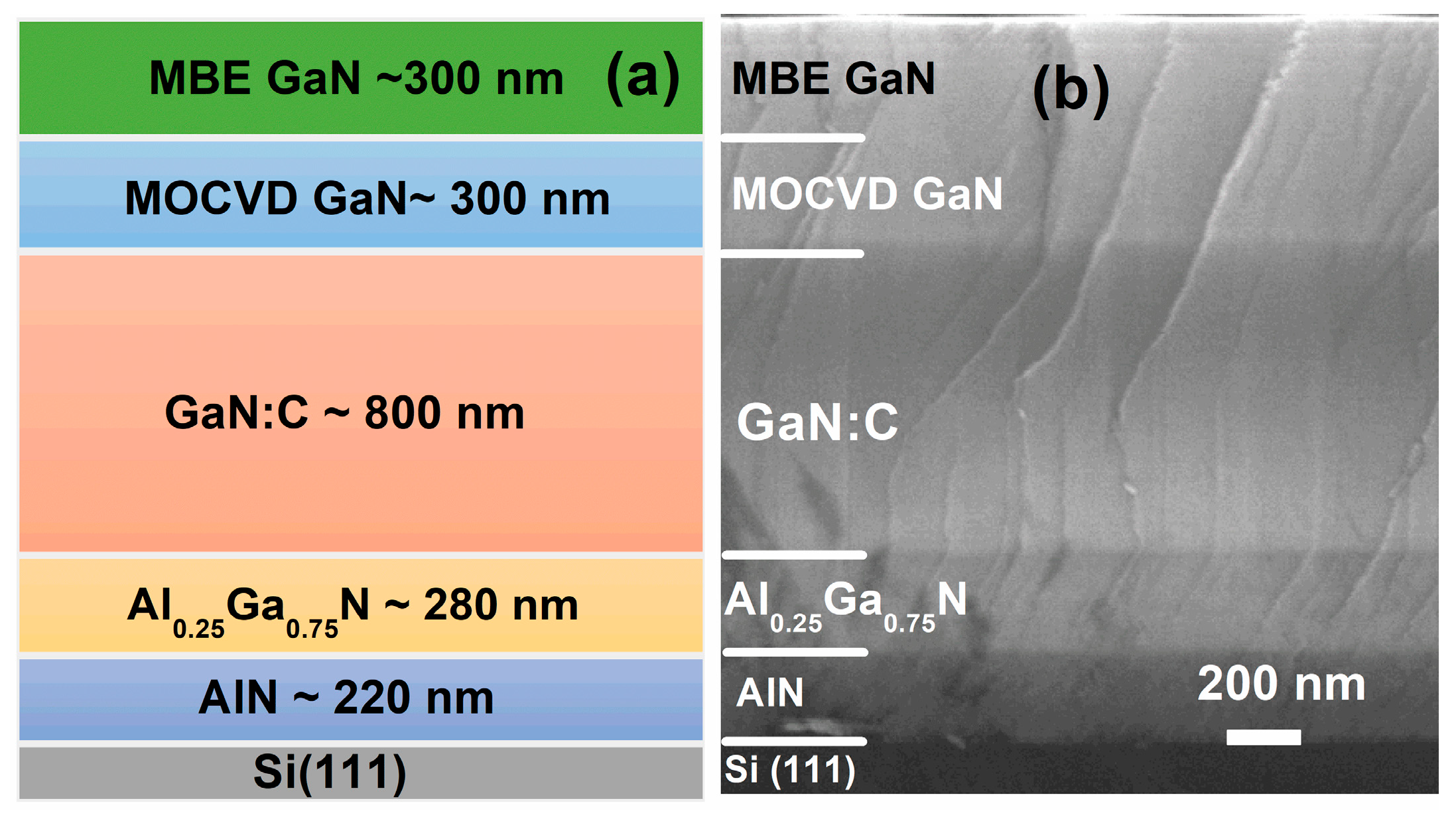
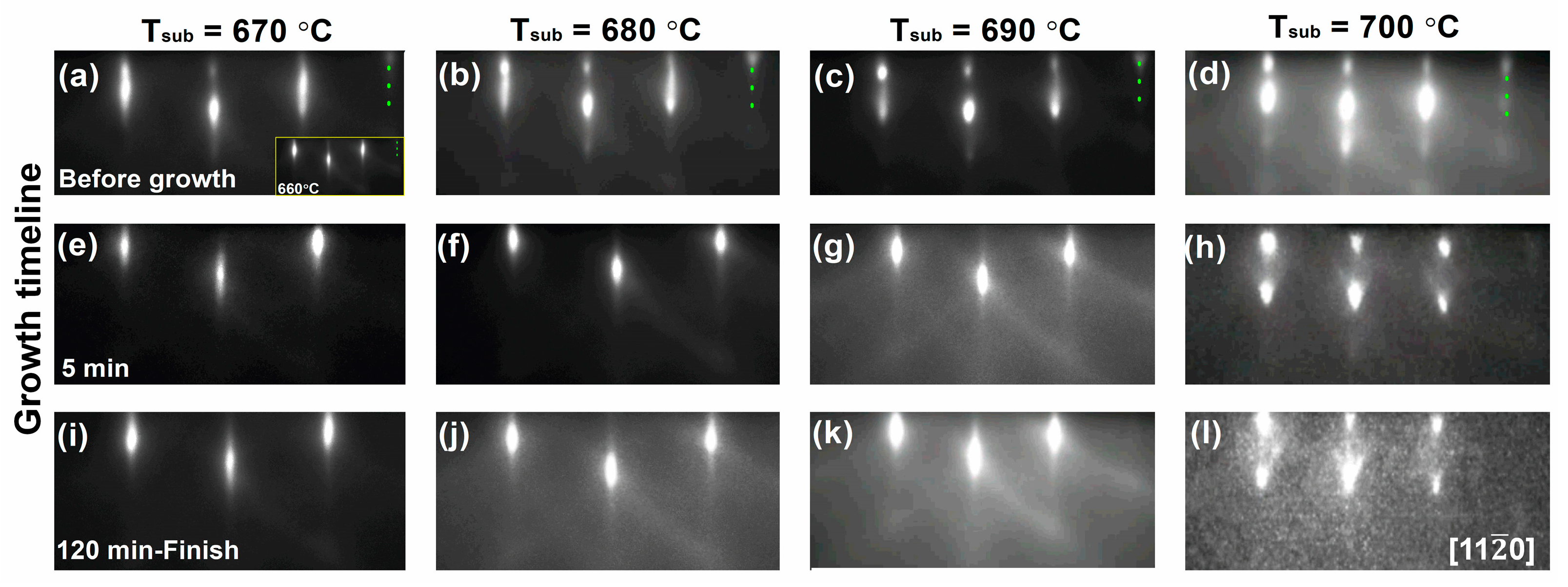
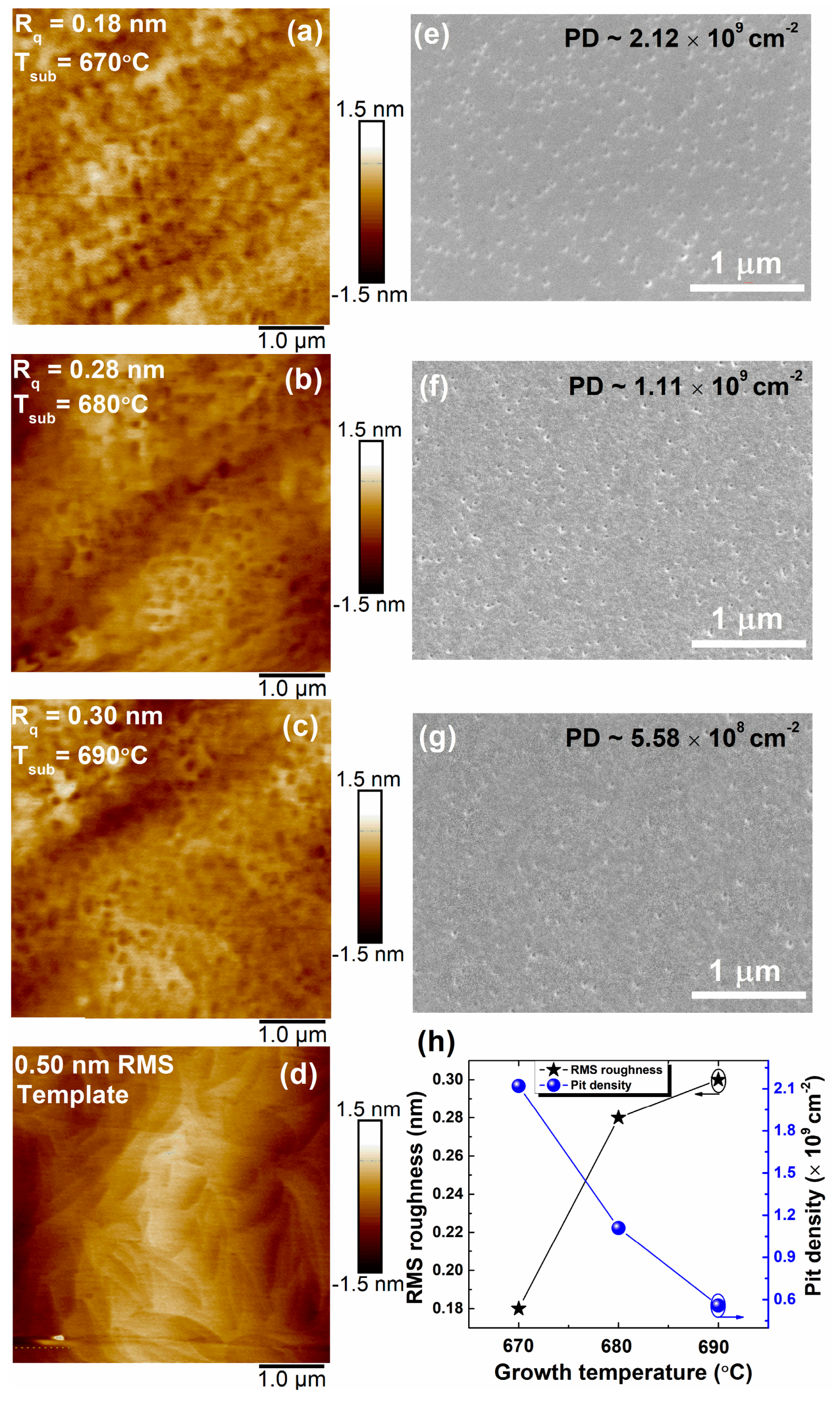
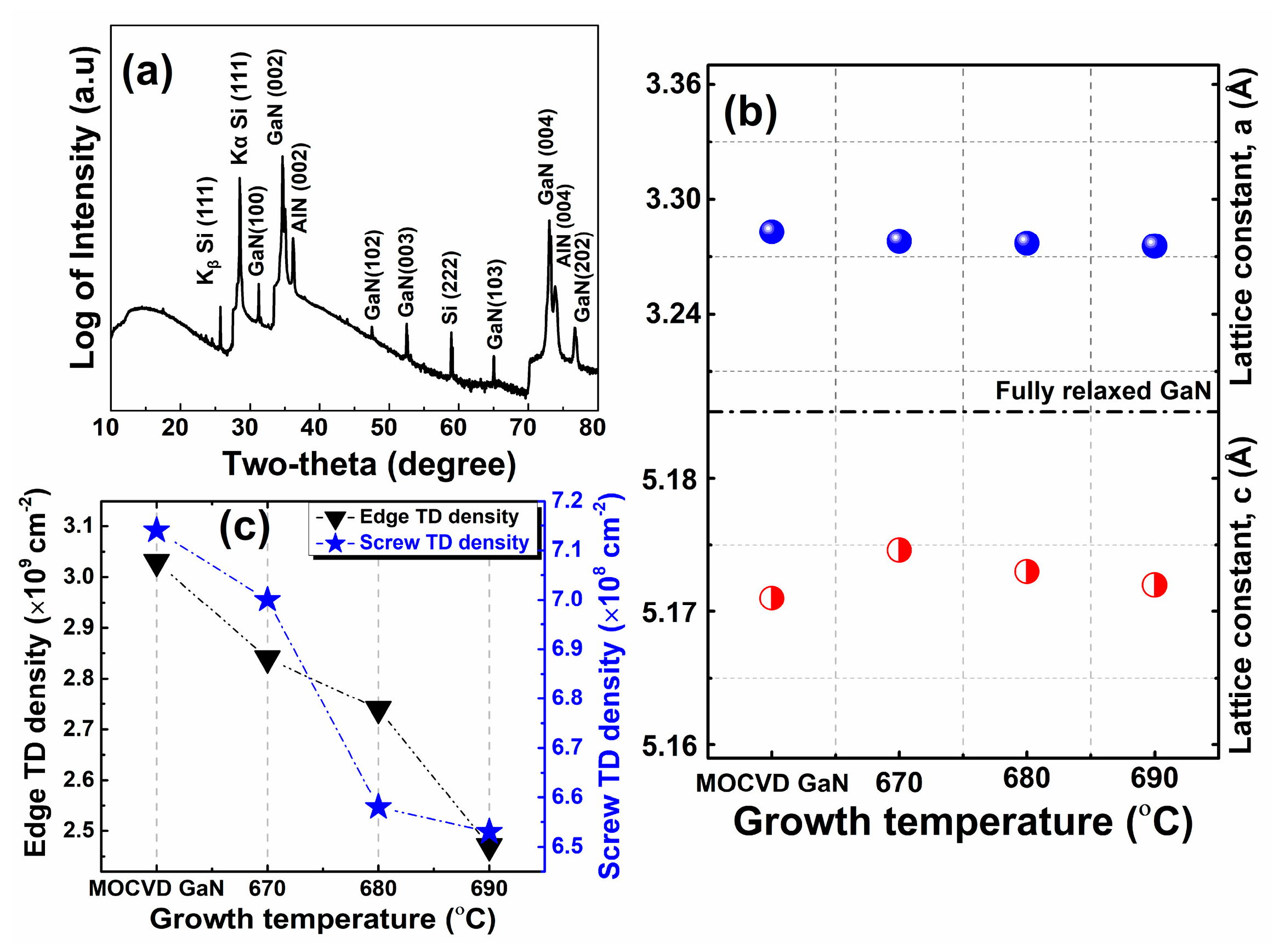
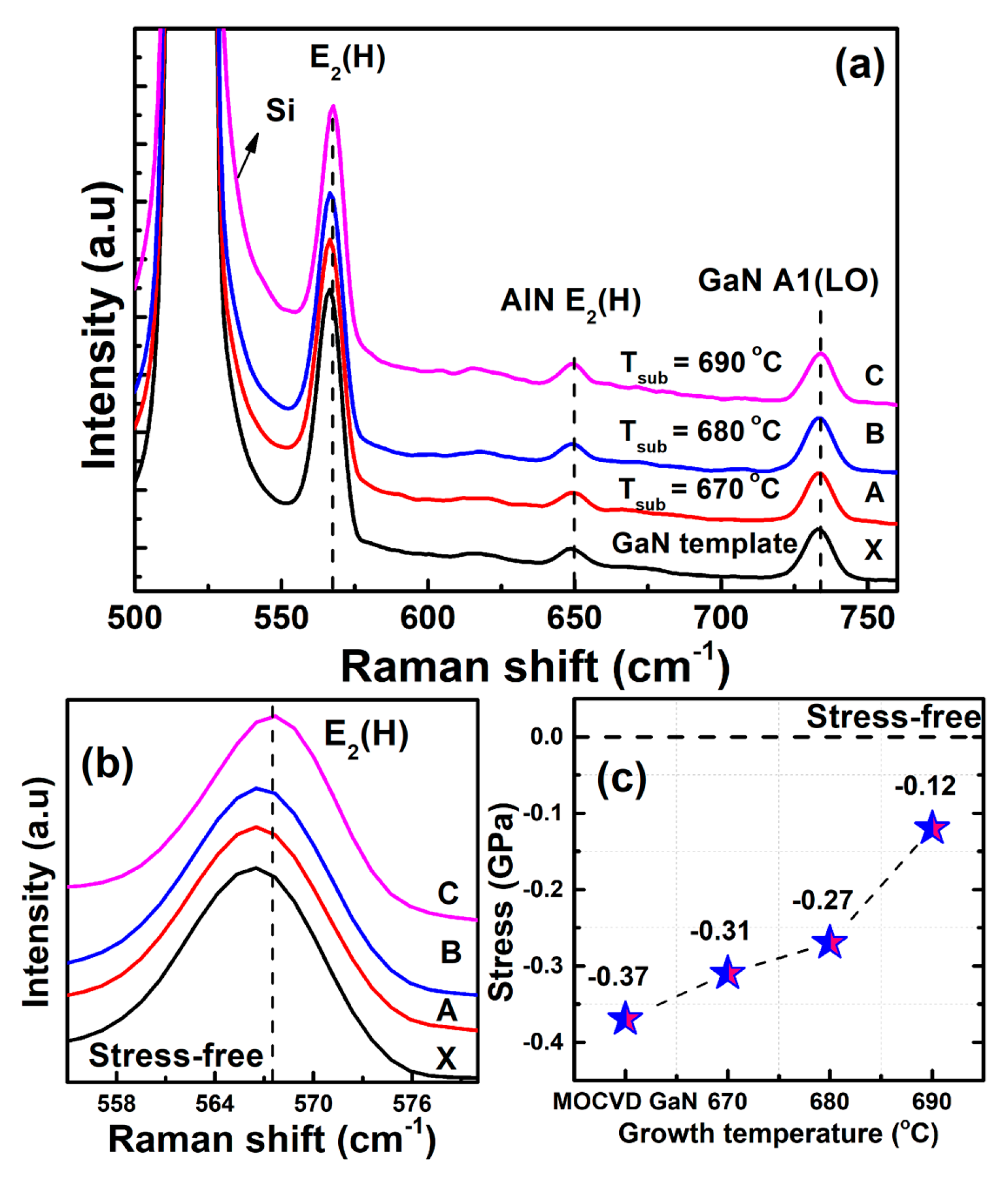

| Sample | Growth Temperature (°C) | Lattice Parameters | FWHM (Arcsec) | TDD (cm−2) | PD (cm−2) | RMS (nm) | Tensile Stress, σ (GPa) | |||
| a (nm) | c (nm) | (002) | (102) | STD | ETD | |||||
| X | MOCVD GaN | 0.3283 | 0.5171 | 596 | 966 | 108 | 109 | - | 0.51 | 0.36 |
| A | 670 | 0.3278 | 0.5174 | 590 | 939 | 108 | 109 | 109 | 0.18 | 0.31 |
| B | 680 | 0.3277 | 0.5173 | 572 | 889 | 108 | 109 | 109 | 0.28 | 0.27 |
| C | 690 | 0.3276 | 0.5172 | 570 | 880 | 108 | 109 | 108 | 0.30 | 0.12 |
Disclaimer/Publisher’s Note: The statements, opinions and data contained in all publications are solely those of the individual author(s) and contributor(s) and not of MDPI and/or the editor(s). MDPI and/or the editor(s) disclaim responsibility for any injury to people or property resulting from any ideas, methods, instructions or products referred to in the content. |
© 2024 by the authors. Licensee MDPI, Basel, Switzerland. This article is an open access article distributed under the terms and conditions of the Creative Commons Attribution (CC BY) license (https://creativecommons.org/licenses/by/4.0/).
Share and Cite
Mai, T.T.; Dai, J.-J.; Chou, W.-C.; Wen, H.-C.; Hieu, L.T.; Luc, H.H. Improving Optical and Electrical Characteristics of GaN Films via 3D Island to 2D Growth Mode Transition Using Molecular Beam Epitaxy. Coatings 2024, 14, 191. https://doi.org/10.3390/coatings14020191
Mai TT, Dai J-J, Chou W-C, Wen H-C, Hieu LT, Luc HH. Improving Optical and Electrical Characteristics of GaN Films via 3D Island to 2D Growth Mode Transition Using Molecular Beam Epitaxy. Coatings. 2024; 14(2):191. https://doi.org/10.3390/coatings14020191
Chicago/Turabian StyleMai, Thi Thu, Jin-Ji Dai, Wu-Ching Chou, Hua-Chiang Wen, Le Trung Hieu, and Huy Hoang Luc. 2024. "Improving Optical and Electrical Characteristics of GaN Films via 3D Island to 2D Growth Mode Transition Using Molecular Beam Epitaxy" Coatings 14, no. 2: 191. https://doi.org/10.3390/coatings14020191







